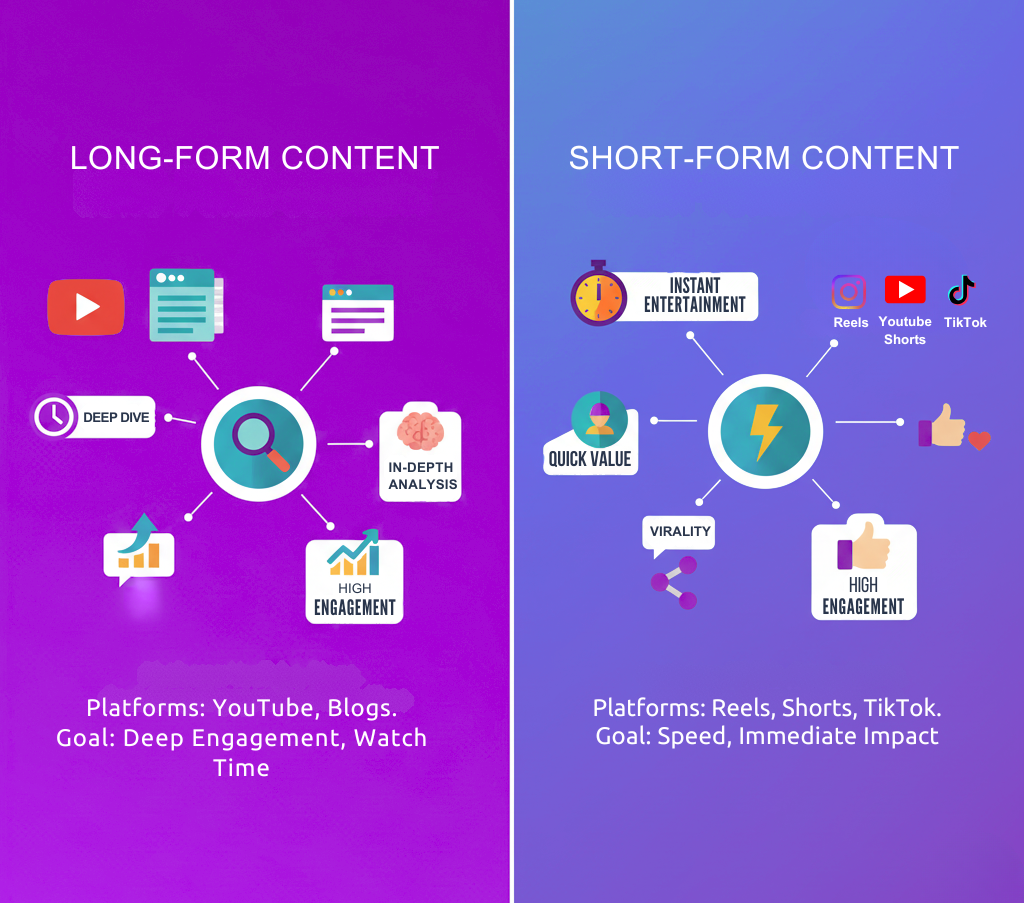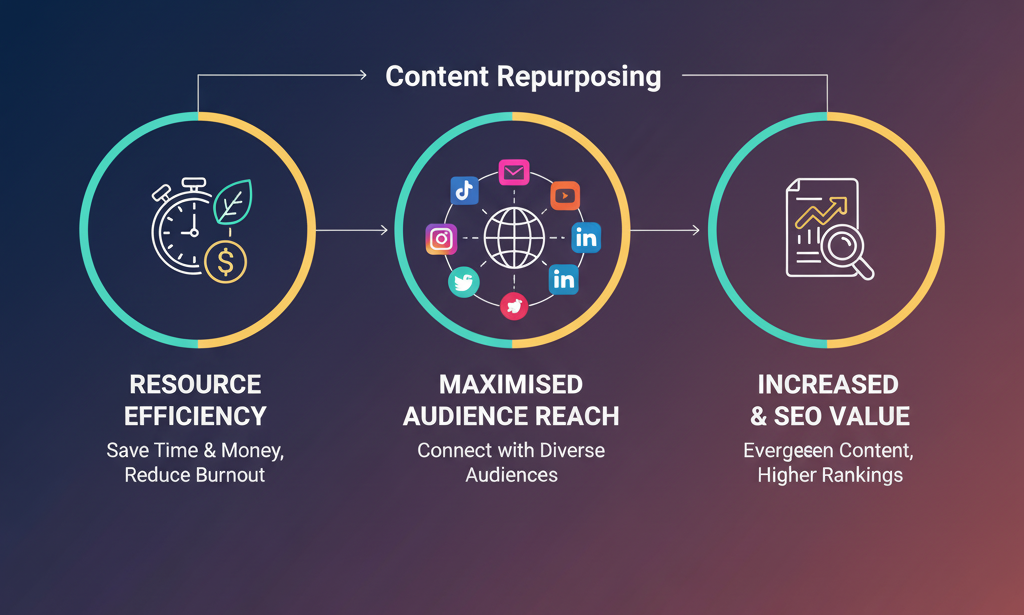The Creator's Guide to Content Repurposing: Maximise Your Reach and Revenue
In a world where attention spans are shrinking and digital platforms are multiplying, creators often feel like they’re on a never-ending treadmill, constantly producing fresh content just to keep up. But what if the secret to growth isn’t creating more, but creating smarter?
That’s where content repurposing comes in. At its core, repurposing means taking a single piece of content and transforming it into different formats tailored for multiple platforms. It’s not just a hack to save time, it’s a strategy to multiply your reach, extend your content’s lifespan, and increase revenue without burning out.
This guide provides an in-depth exploration of the techniques and strategies behind content repurposing, particularly focusing on the differences between long-form and short-form content platforms.You will discover how to identify share-worthy moments, adjust video content for various platforms, and leverage blogs to create a strong social media presence.
Understanding the Digital Content Ecosystem: Long-Form vs. Short-Form
The modern digital landscape is a diverse ecosystem, fundamentally characterized by a divide between long-form and short-form content platforms. Each segment features unique audience behavior and distinct algorithmic priorities, necessitating a nuanced approach to content strategy.
1. The Power of Long-Form Content Platforms
Platforms like YouTube and well-maintained Blogs are primarily built for long-form content. Here, the goal is deep engagement. Creators can delve deeply into complex topics, providing thorough analysis, in-depth tutorials, or detailed storytelling that keeps viewers or readers engaged for extended periods.
- Audience Behavior: Viewers on these platforms are often in a 'learning' or 'entertainment seeking' mode, willing to commit time for comprehensive value.
- Algorithmic Focus: Algorithms reward watch time and session duration, prioritizing content that keeps users on the platform longer.
2. Mastering the Short-Form Content
In contrast to long-form, platforms like TikTok, Instagram Reels, and YouTube Shorts prioritise speed and immediate impact. Think of this as content designed for the mobile scroller.
- Audience Behavior: Users on these platforms are moving fast, seeking instant entertainment, quick value, or rapid bursts of information. They are in 'scrolling mode' and will swipe away instantly if not hooked.
- Algorithmic Focus: These algorithms reward content that is short, highly engaging (likes, comments, and shares), and quickly consumable. A key characteristic here is virality. These platforms are designed to push engaging content to millions, regardless of your follower count

Why Content Repurposing is Your Growth Accelerator
Effective content repurposing means taking content from one format (e.g., a 30-minute podcast) and presenting it in another (e.g., ten 30-second video clips, a detailed blog post, and five quote graphics), maximising its reach and extending its lifespan.
- Resource Efficiency (The Time-Saver): Instead of facing the constant pressure of 'starting from scratch' for every platform, creators can adapt existing, proven content. According to a study 60% of marketers reuse content up to five times, citing efficiency and better results as key motivators.
- Maximised Audience Reach: Different demographics engage with different content formats. What performs spectacularly on TikTok might require a different spin to resonate with the professional audience on LinkedIn. By repurposing, you organically reach various segments across the digital sphere.
- Increased Longevity and SEO Value: An Instagram Story disappears after 24 hours, but a detailed blog post or pillar video can continue to generate traffic and improve your Search Engine Optimisation (SEO) for months or even years. Repurposing effectively extends the content’s value and lifespan.

The Strategic Process of Content Repurposing
This is where strategy meets execution. Follow these steps to build an efficient creator workflow:
Step 1: Identify Share-Worthy Moments
The foundation of repurposing is knowing what works.
- Review Your Existing Content: Revisit your videos, blog posts, or podcast transcripts. Look for "aha!" moments, definitive conclusions, impactful quotes, entertaining segments, or clear statistical data.
- Utilise Audience Engagement Data: Use platform analytics to identify sections that generated the most engagement - high comment counts, high share rates, or a spike in viewer retention. This data validates what truly resonates with your audience.
Step 2: Editing for Different Formats
Once you've identified the high-value segments, it is time to adapt them. You need to edit and format these moments to perfectly fit the platform you're using.
For Video Content (Long to Short):
- Aspect Ratio is Non-Negotiable: Videos for vertical platforms like Instagram Reels, Stories, or TikTok must be in a vertical 9:16 aspect ratio. Cropping a horizontal YouTube clip (16:9) to fit is crucial to dominating the mobile screen.
- Captions: Manually adding captions (not just platform-generated ones) is absolutely essential for social media. Data suggests that 85% of social media videos are watched without sound, so captions ensure your message is delivered even in a sound-off environment.
- Platform-Specific Enhancements: Incorporate entertaining elements relevant to the platform's current culture, such as trending audio, viral challenges, or platform-specific stickers and effects to blend in seamlessly with the feed.
For Blog Posts (Text to Visuals/Snippets):
A single, comprehensive blog post is a true content treasure trove, capable of fueling your social media for weeks.
- Extract Quotes & Text Cards: Pull the most impactful quotes or key data points and present them as visually appealing image posts (Quote Graphics or Carousels).
- Create Infographics: Convert complex data, statistics, or procedural guides (e.g., a "How-To" list) from your blog into simple, digestible infographics to drive engagement on visual platforms like Pinterest or Instagram.
- Summarise Key Themes: Break down the main themes into bite-sized, bulleted snippets for an effective X (Twitter) thread or a quick LinkedIn update, linking back to the full article for the comprehensive read.
Step 3: Maintaining Each Platform's Unique Flavor
While the core message remains the same, the delivery must adapt to the platform's culture.
- YouTube: Content should be informative, instructional, or deeply entertaining. Focus on cinematic quality and comprehensive storytelling.
- Instagram (Feed/Stories): Aesthetic quality is paramount. Use high-quality visuals on Stories for authentic, emotional connection and behind-the-scenes content.
- TikTok: Prioritise entertainment, immediacy, and creativity. Short, snappy videos that incorporate current humor or trending sounds go a long way.
Using Blogs to Create a Robust Social Media Presence
A well-written blog post is the ideal "Pillar Content" from which to repurpose.
- Deconstruct into Multiple Posts: Break down a 2,000-word blog post into 5-10 distinct social media posts that highlight different aspects of the topic (e.g., one post for a statistic, one for a quote, one for the key takeaway).
- Engaging Call to Action (CTA): The CTA in repurposed content shouldn't always be a direct sale. Encourage curiosity by inviting the audience to share their thoughts or ask a related question. For example: "Which of these three content strategies are you trying first? Let me know in the comments!"
- Utilise Visuals: Convert sections of the blog into infographics or quote images to significantly enhance shareability, as visual content generally performs better in discovery feeds.
Making the Most of Analytics
Since repurposing is an ongoing process, it is important to keep checking your analytics. These tools show you what content performs best so you can continually refine your strategy.
- Engagement Rates: Analyse which type of repurposed content yields the highest engagement (e.g., do infographics work better than quote cards?). Adjust your future repurposing strategy accordingly.
- Demographic Data: Understanding who engages with your repurposed content on each platform helps you tailor the language, references, and style for maximum impact in future efforts.
Conclusion: Transform Your Content Strategy
You now possess the knowledge of why content repurposing is crucial and how to implement it effectively into your creator workflow. When you strategically tailor content for both long-form and short-form platforms, you can transform your reach and significantly increase your income.
Content repurposing isn't just about saving time. It is about strategically creating multiple opportunities to engage and connect more meaningfully with your entire audience, regardless of where they spend their time online. Start transforming your content today!
Sources





